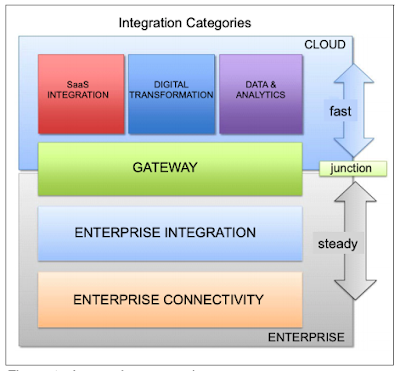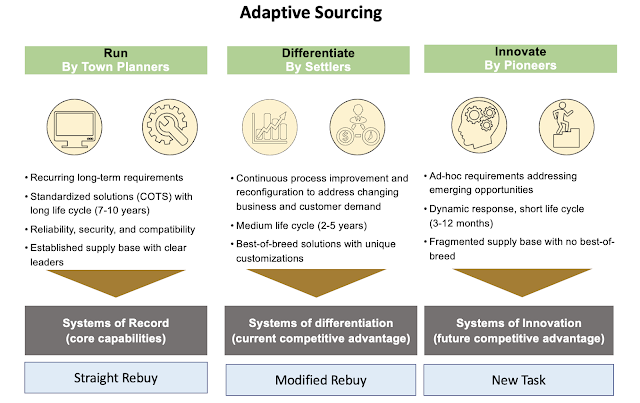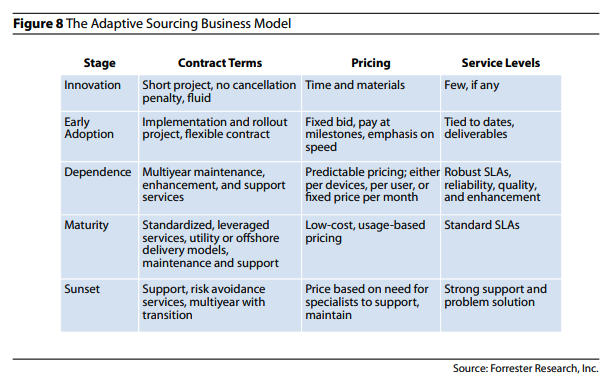The Deep Dive into Bimodal Procurement
What is Bimodal procurement?
"Bimodal procurement" is the top search suggested by Google Search for this blog.
Apparently, people are looking for something that barely exists. There are such significant concepts as Bimodal IT and Adaptive sourcing.
The mixture of these two possibly created hybrid notions of "bimodal procurement" or "bimodal sourcing." Yet, we can provide the following definition aligned with the principles of bimodal IT.
Bimodal procurement assumes two operating modes - one suited for the business-as-usual (BAU) and another for new requirements, e.g., innovation.
BAU mode is based on stability, quality, and cost-efficiency. Innovation mode is based on speed, agility, and business value.
We'll now provide in-depth research on bimodal and multimodal sourcing and procurement concepts. We'll also propose a hybrid sourcing strategy that practices our theoretical definitions.
Spoiler: If you read this till the end, you will find that bimodal procurement exists.
Bimodal IT operating model by Gartner.
Perhaps that was the reason IT became T&I—Technology and Innovation. The new name perfectly characterizes the bimodal nature of operations.

Two-speed IT by IBM
- mode 1 (reliability) assumes concluding long-term deals with Enterprise suppliers;
- mode 2 (agility) takes short-term deals with small new vendors.
Loopholes in the concept of bimodal procurement
The complexity of IT and business alignment in bimodal IT
The core of bimodal IT misalignment
Procurement needs to master many roles.
Gartner pace layering
We just touched upon two distinct operating modes of IT (or T&I.) However, another dimension of complexity represents different types of technology systems.
Pace layers by Stewart Brand
In his book "How Buildings Learn: What's Happen After They Are Built" (1994), Stewart Brand mentioned that buildings are composed of several layers of change, each developing at its own pace.
Later, he extended the same logic to civilizations having different layers - nature, culture, governance, infrastructure, commerce, and fashion. Manner demonstrates the quickest pace of development, unlike nature.
"Consider the differently paced components to be layers. Each layer is functionally different from the others and operates independently. Still, each layer influences and responds to the layers closest to it in a way that makes the whole system resilient."
Brand noted that all durable, dynamic systems have this structure, making them adaptable and robust.
Gartner's realization of a pace-layered strategy
Gartner suggested the following classification:- Systems of Record – these systems enable an organization's core capabilities and run mission-critical business processes. Usually, these are Commercial Off-the-Shelf (COTS) products with minimum or no customization (e.g., ERP, CRM, Data Warehouse, MDM (Master Data Management), HR systems.) These systems could be further differentiated by application areas, i.e.,
- Finance (SAP)
- Customer (Salesforce)
- HR (Workday)
- IT (ServiceNow)
- Operations (Maximo.)
- Systems of Differentiation – applications in this layer represent the processes that make an organization unique and typically are not accommodated out of the box by vendor-provided Systems of Record platforms. These systems are highly customizable. (Examples: BI (Business Intelligence) and reporting, customer service, e-commerce.)
- Systems of Innovation – These applications represent new ideas and technologies, which are rapidly developed and then manually deployed and tested. Such systems satisfy ad-hoc business requirements and employ consumer-grade technologies. (Examples: digital sales channels, social platform selling, customer experience, mobile e-commerce, merchandising.)
Adaptive sourcing
Finally, we have reached the concept of adaptive sourcing.The notion of "adaptivity."
Our view of Adaptive Sourcing
Adaptive sourcing by Forrester

3D Dynamic procurement model
To work on this further, we propose the following 3D dynamic procurement model.
"Innovate," "Differentiate," and "Run" axes form three planes, where we can place three critical procurement deliverables – Value, Relationships, and Processes/Systems.
Usually, the value is achieved by improving existing practices (Run) and developing unconventional ones (Innovate.)
Processes and systems require differentiation (e.g., for different user groups) and innovation for further development.
Relationships must be maintained (Run) and differentiated (e.g., supplier segmentation.)
We formed this simple model and may use it to visualize our strategy.
Let's assume that the triangle has a constant area, so you cannot simply enlarge it, and, e.g., each upward movement of any of its points results in different moves of other points (including downward ones.)
It is suggested to fix at least one point of the triangle, as having all three moving issues would increase the dynamism to the uncontrolled state, where each move creates sudden changes across the model.
In the times of Industry 4.0, innovation cannot stop, and the constant search for new efficiencies and values through operational improvement (Run.)
Therefore, you would likely stabilize (fix) the differentiation. Otherwise, further relationship improvement would happen at the cost of extreme customization of processes and systems.
We can fix the point on the Innovate ax and view the changes on two other axes.
For example, we're to increase innovation. In that case, the triangle starts moving downwards on the Run ax, and the value element related to operations (Run) could deteriorate while the innovation value increases. Relationships with critical suppliers could also suffer, as you'd start putting more effort into developing their startup rivalry.
Vice versa, too much emphasis on improving existing operations would result in an upward motion on Run ax and degrading innovations.
We propose this model as a possible visualization of multiple dimensions of procurement and their dependencies.
It is suggested to fix at least one point of the triangle, as having all three moving issues would increase the dynamism to the uncontrolled state, where each move creates sudden changes across the model.
In the times of Industry 4.0, innovation cannot stop, and the constant search for new efficiencies and values through operational improvement (Run.)
We can fix the point on the Innovate ax and view the changes on two other axes.
Vice versa, too much emphasis on improving existing operations would result in an upward motion on Run ax and degrading innovations.
We propose this model as a possible visualization of multiple dimensions of procurement and their dependencies.













Comments
Post a Comment